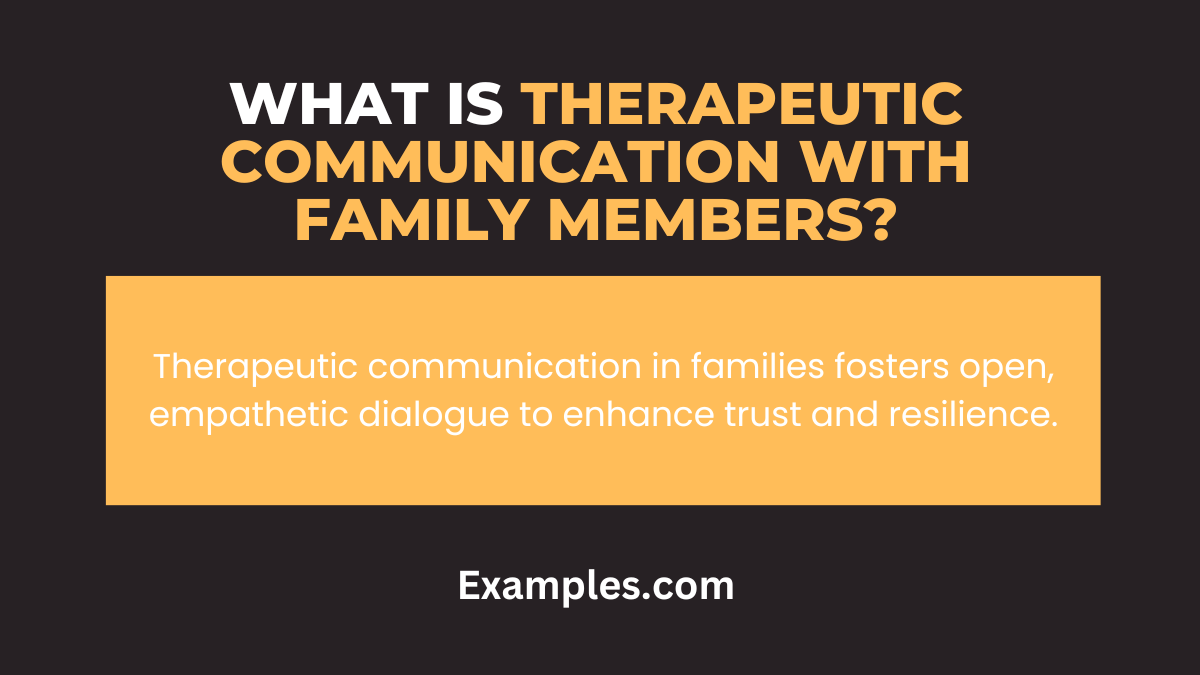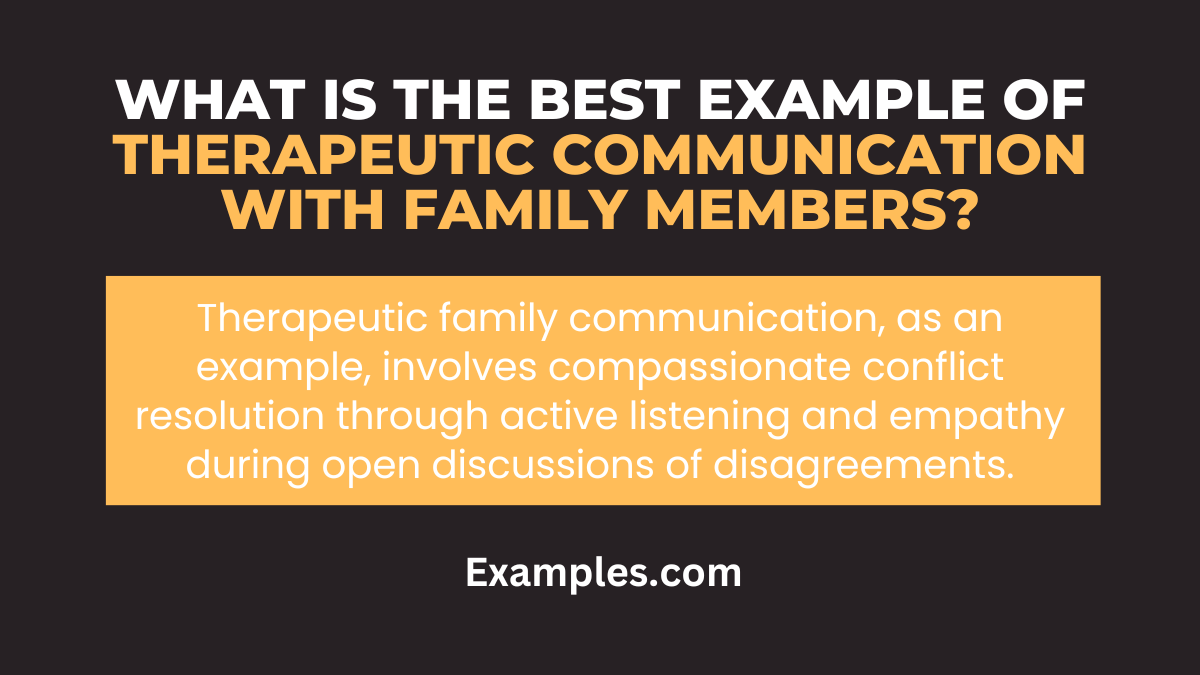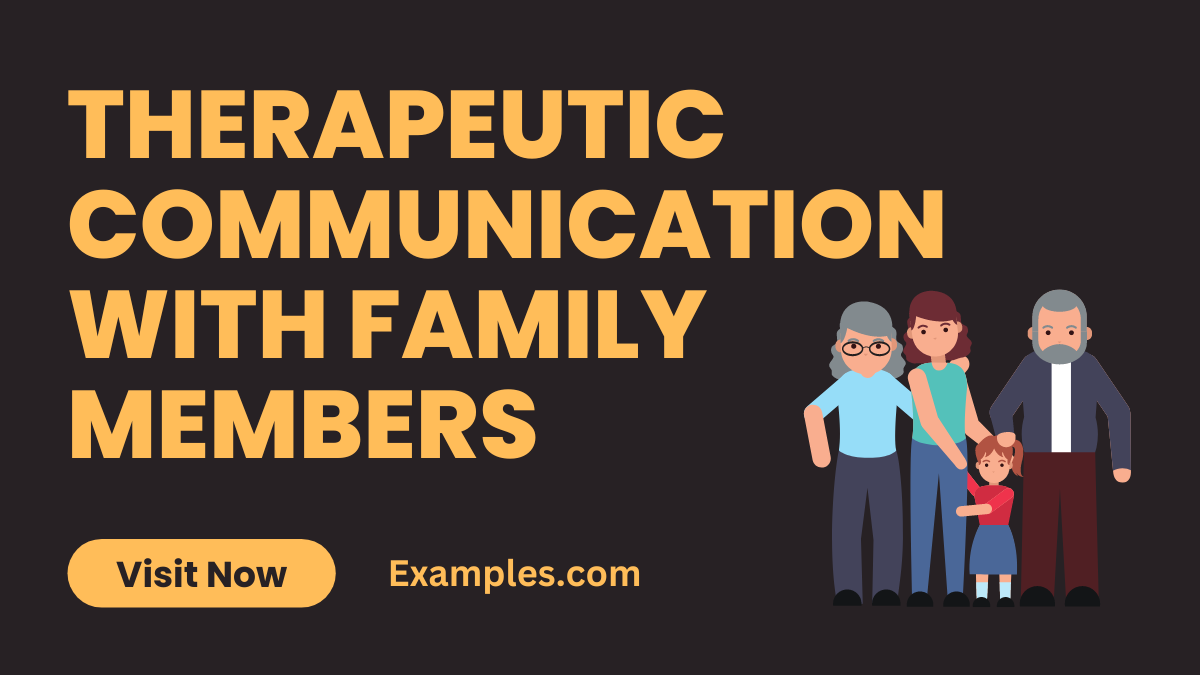Therapeutic Communication with Family Members
In the realm of family dynamics, therapeutic communication serves as a cornerstone for fostering meaningful connections, resolving conflicts, and offering support. This comprehensive guide delves into the art of therapeutic communication with family members, shedding light on its significance and providing practical examples to navigate complex relationships and emotions.
What is Therapeutic Communication with Family Members?

Therapeutic communication with family members is a specialized form of interaction that emphasizes open and empathetic dialogue within the family unit. It revolves around active listening, understanding, and effective expression of emotions to promote harmony, trust, and resilience in familial relationships. This section defines the essence of therapeutic communication within the context of family dynamics, offering clarity in simple terms.
What is the Best Example of Therapeutic Communication with Family Members?

The best example of therapeutic communication with family members occurs when family members engage in a compassionate and nonjudgmental conversation during a conflict. This involves active listening, where each party allows the other to express their perspective without interruption. Through empathetic responses, validation of feelings, and a willingness to find common ground, family members can resolve issues, strengthen their bond, and cultivate an environment of mutual understanding and support. This section delves into the intricacies of this exemplary communication practice, highlighting its transformative potential within families.
15 Therapeutic Communication with Family Members Examples
Effective therapeutic communication within families is essential for maintaining healthy relationships and resolving conflicts. In this section, we present 15 unique examples that demonstrate how to communicate with family members in ways that nurture understanding, empathy, and cohesion.
- Active Listening: When a parent listens attentively to their child’s concerns about school, without interrupting or offering solutions, it shows that they value their child’s feelings.
- Empathetic Responses: Responding to a sibling’s disappointment with empathy and understanding, such as, “I can imagine how frustrating that must be,” fosters emotional connection.
- Conflict Resolution: When family members engage in a calm and respectful discussion to resolve a disagreement, it leads to healthier relationships. Example: “Let’s talk about our differences and find a solution together.”
- Validation of Feelings: Acknowledging a family member’s feelings without judgment, like saying, “It’s okay to be upset,” helps them feel heard and supported.
- Sharing Emotions: Expressing vulnerability and sharing personal emotions within the family can encourage others to do the same, promoting openness.

- Problem-Solving Together: Collaborative problem-solving strengthens family bonds. For instance, “We’re facing this challenge as a family, and we’ll work through it together.”
- Setting Boundaries: Communicating and respecting personal boundaries ensures everyone’s comfort and well-being within the family.
- Expressing Gratitude: Saying “thank you” and showing appreciation for family members’ efforts reinforces positive interactions.
- Avoiding Blame: In disagreements, avoiding blame and instead focusing on finding solutions helps maintain a harmonious atmosphere.
- Encouraging Open Dialogue: Promoting a culture of open and honest communication allows family members to express themselves without fear.
- Nonverbal Communication: Nonverbal cues like hugging or holding hands can convey love and support when words fail.
- Avoiding Interruptions: Letting family members finish their sentences before responding demonstrates respect and patience.
- Active Engagement: Actively participating in family activities and events fosters a sense of togetherness.

- Understanding Differences: Recognizing and appreciating each family member’s uniqueness promotes tolerance and acceptance.
- Apologizing Sincerely: When a family member apologizes for a mistake genuinely, it can mend wounds and rebuild trust. Example: “I’m sorry for what I said earlier; it was wrong of me.”
What are Some Therapeutic Communication Techniques with Family Members?
When it comes to family dynamics, therapeutic communication techniques play a pivotal role in maintaining harmony and resolving conflicts. Here are several techniques that can be particularly effective in nurturing healthy family relationships:
- Active Listening: Listening actively involves giving your full attention to the family member who is speaking, showing empathy, and refraining from interrupting. By doing so, you convey that their thoughts and feelings are valued.
- Use of “I” Statements: Express your own feelings and thoughts with “I” statements instead of blaming or accusing others. For example, say, “I feel hurt when you don’t include me in family decisions” rather than, “You always make decisions without me.”
- Empathy: Empathizing with a family member’s emotions by acknowledging their feelings and trying to understand their perspective fosters understanding and closeness.
- Open and Honest Communication: Encourage open dialogue within the family, where everyone feels comfortable expressing themselves without fear of judgment.
- Conflict Resolution Skills: Teach and apply conflict resolution techniques, such as compromise and negotiation, to address disagreements in a constructive manner.
- Validation of Feelings: Let your family members know that their feelings are valid, even if you don’t necessarily agree with their perspective. Validation creates an atmosphere of acceptance.
- Nonverbal Communication: Be mindful of your nonverbal cues, such as facial expressions and body language, as they can communicate just as much as words.
- Setting Boundaries: Establish and respect personal boundaries within the family, which ensures that everyone feels safe and comfortable.
- Effective Feedback: Offer feedback constructively, focusing on behavior or actions rather than making personal judgments or criticisms.
- Use of “I” Statements: Avoid using “you” statements that might sound accusatory. Instead, say, “I feel concerned when we argue,” which is less confrontational.
- Time Management: Allocate quality time for family interactions, whether through family dinners, outings, or dedicated family meetings.
- Avoiding Blame: When conflicts arise, refrain from blaming or shaming family members. Instead, concentrate on finding solutions together.
How do you Therapeutically Communicate with Family Members?
Therapeutically communicating with family members involves a deliberate approach aimed at fostering understanding, empathy, and mutual support. Here’s a step-by-step guide on how to effectively communicate within your family:
- Active Listening: Practice active listening by giving your full attention to the speaker. Maintain eye contact, nod to show understanding, and refrain from interrupting.
- Empathy: Put yourself in the other person’s shoes and try to understand their perspective. Acknowledge their emotions and express empathy.
- Validation: Validate the other person’s feelings, even if you disagree with their viewpoint. Let them know that their emotions are valid.
- Use “I” Statements: Express your thoughts and feelings using “I” statements to avoid sounding accusatory. For instance, say, “I feel hurt when you don’t consider my opinion.”
- Conflict Resolution: When conflicts arise, focus on finding solutions together rather than placing blame. Use compromise and negotiation to reach mutually satisfactory resolutions.
- Open Dialogue: Encourage open and honest communication within the family. Create a safe space where everyone can express themselves freely.
- Nonverbal Communication: Pay attention to your nonverbal cues. Your body language and facial expressions should align with your words.
- Setting Boundaries: Establish personal boundaries and respect the boundaries of others. This ensures everyone feels comfortable and respected.
- Quality Time: Spend quality time together as a family, whether through family activities, meals, or dedicated family meetings.
- Feedback: Offer feedback constructively, focusing on specific behaviors or actions rather than making personal criticisms.
Mastering the art of therapeutic communication with family members is essential for building strong, harmonious relationships. By implementing techniques like active listening, empathy, and open dialogue, families can navigate conflicts, express their emotions, and create an environment of understanding and support. Effective communication within families not only resolves issues but also strengthens bonds, fostering a sense of togetherness that stands the test of time.



